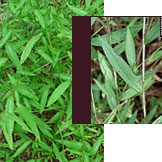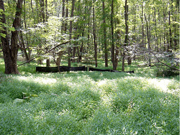Japanes Stiltgrass
By:Damian Varga
Winter 2010
Misdiagnosis and Enlightenment
“I’ve never seen this stuff before!” My exact words when I inspected a property in western Howard County five years ago. I believe I am quite knowledgeable about weeds, however, this one had me stumped. I sent a sample to have it identified to the University of Maryland Extension Service and I was told it was Asiatic Dayflower. WRONG ! It took a considerable amount of research for me to discover it was a Dayflower look-a-like called Japanese Stilt grass. Japanese Stiltgrass, also known as Chinese Packing Grass, Nepalese Browntop and Deergrass, is an exotic invasive grass species introduced into the United States in Tennessee in 1919. It was once used as packing material for shipping porcelain from Asia, hence the Packing Grass moniker, and this is how it escaped into the wild down South. It is currently found along the east coast from Florida to New York and westward into Tennessee, Kentucky and Indiana.
 Since this annual grassy weed is well adapted to low sunlight it will invade disturbed shaded areas, such as properties adjacent to woods. Many forests are becoming over-grown by this pest plant. It is spread in rural areas is affected by white-tailed deer activity- traffic and browsing. Additionally, deer will hasten the spread of Stiltgrass by feeding on native vegetation and avoiding foraging on the Invader. A single plant is able to produce between 100-1000 seeds which are capable of viability for up to three years in the soil. Seeds can be carried by human foot traffic and on the feet of animals. Seeds may also be dispersed by runoff from rain, flood waters and streams, as well as hay and soil. Stiltgrass germinates in the Spring and continues to germinate through the growing season (not unlike Crabgrass) until first frost when the plant dies.
Since this annual grassy weed is well adapted to low sunlight it will invade disturbed shaded areas, such as properties adjacent to woods. Many forests are becoming over-grown by this pest plant. It is spread in rural areas is affected by white-tailed deer activity- traffic and browsing. Additionally, deer will hasten the spread of Stiltgrass by feeding on native vegetation and avoiding foraging on the Invader. A single plant is able to produce between 100-1000 seeds which are capable of viability for up to three years in the soil. Seeds can be carried by human foot traffic and on the feet of animals. Seeds may also be dispersed by runoff from rain, flood waters and streams, as well as hay and soil. Stiltgrass germinates in the Spring and continues to germinate through the growing season (not unlike Crabgrass) until first frost when the plant dies.
There are several management strategies for Japanese Stiltgrass. Annual grassy weeds (crabgrass for example) are best controlled using pre-emergence herbicides. The same products can be used to manage this weed. In turf, post-emergence herbicides such as Acclaim are labeled for management. If the grass is in an area with little other vegetation, the old reliable Round Up will provide excellent control, however, care must be taken because RoundUp is non-selective and will kill anything that gets sprayed. Stiltgrass is a shallow-rooted plant and can also be managed manually. Hand removal and/or digging of plants are effective control methods if the number of grass plants are not totally pervasive.
Proper identification is crucial. A common warm season perennial grass, nimblewill looks similar to Stiltgrass
and is currently not selectively controlled in home lawns (a new chemical Tenacity is on the market to control Nimblewill on Golf Courses only-hopefully the Home Lawn market is on the horizon).
 Scientific Plant Service Lawn Care Program is not only Chesapeake Bay friendly with state of the art fertilizer, but will manage Japanese Stilt grass in your lawn providing you have a Full Lawn Program (T1, T2, T4). For more information or should you have questions, please contact your service rep!
Scientific Plant Service Lawn Care Program is not only Chesapeake Bay friendly with state of the art fertilizer, but will manage Japanese Stilt grass in your lawn providing you have a Full Lawn Program (T1, T2, T4). For more information or should you have questions, please contact your service rep!

